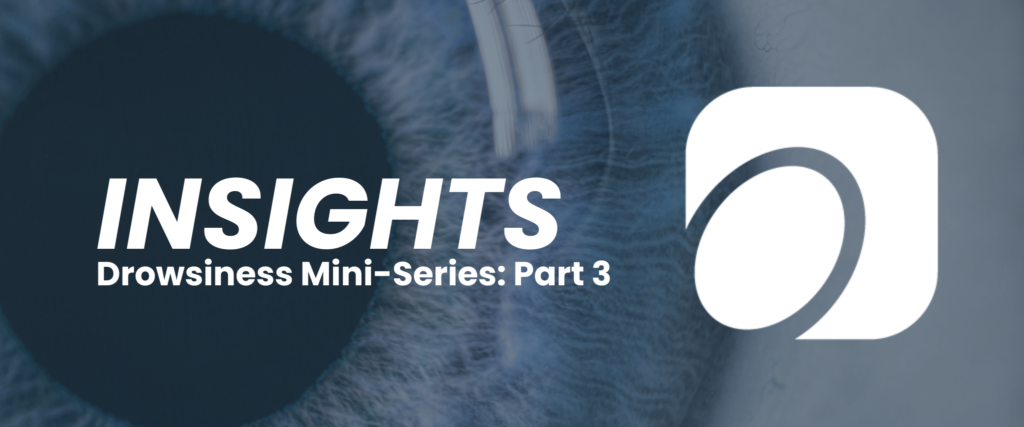
How is Drowsiness Measured?
Last episode, the drowsiness regulation process in humans was discussed. However, to apply this understanding to real world situations we need to be able to objectively measure drowsiness levels. So how is drowsiness measured?
There are two classes of methods for measuring drowsiness: objective and subjective. Objective measures are independent of the observer, meaning they do not rely on the perception of how drowsy the subject feels or looks. In a different scenario, this may be compared to measuring temperature with a thermometer. Subjective measures are dependent on the observer’s perception, opinion and feeling of a drowsiness condition. In a similar use-case, a subjective measure would be to ask the subject how hot/cold they feel.
There are several ways to measure drowsiness objectively. These methods normally involve the use of equipment (e.g. camera) and/or a skilled technician to collect the measurements and analyse the results. For example, drowsiness may be assessed by measuring eyelid movements. Blinks are often characterised by their duration and frequency of occurrence, both of which change when a person is drowsy. These measurements are accurately and gradually scaled, providing a precise reflection of a subject’s drowsiness levels.
On the other hand, subjective measures involve asking questions from which to infer a person’s drowsiness levels. Such questionnaires have been developed over many years of research and have been widely used in sleep medicine. One example is the Karolinska Sleepiness Scale (KSS), a 9-point scale that is used to assess sleepiness levels, with 1 being extremely alert and 9 being very sleepy.
It is natural to query whether one technique is better than the other. Subjective measurements are frequently used and are handy when objective measures are not easily accessible. For example, if a thermometer is not available, asking a patient to describe how hot or cold they feel is often an acceptable indicator of a fever, unless exact measurements are required for diagnosis. Subjective measurements are also an accurate method for assessing a person’s understanding or feelings about a particular topic. For example, open-ended exam questions allow students to be creative and critical in constructing their answers, providing teachers greater scope to assess their understanding of the topic.

But what if a person’s state of mind is compromised? How much can we depend on their ability to make a judgement about their current condition and consequently, assume that their judgement is not influenced by their current situation? Picture a scene where traffic police have just pulled over a driver for swerving across multiple lanes. The officer approaches the driver, who appears dazed and smells of alcohol. Naturally, the officer would use a breathalyser to objectively assess the driver’s blood alcohol content (BAC). In this situation it would be farcical to ask the driver to assess their own level of inebriation. Not only would the driver be a poor judge of their own condition, but there is also incentive for them to underestimate their BAC to avoid being penalised!

The same can be said about drowsiness. Subjective measurements of drowsiness are cheap and easy to administer as they only involve asking a series of relevant questions. However, these measures can be problematic. Consider the following:
- On a 9-point drowsiness scale, can you accurately differentiate between being a 6 or a 7?
When someone is asked to report on their level of drowsiness during the transitional phase between wakefulness and sleep, the questionnaire’s subjectivity can lead to an inaccurate indication of their drowsiness level.
- Is my self-reported score of 3 equivalent to your score of 3?
Subjectivity also means the perception and interpretation of questions could differ between people when they assess their own drowsiness score; a difference that is difficult to reconcile.
- How drowsy are you now? How about now? How about now? How about now?
Studies have shown that actively asking someone to self-assess their drowsiness level affects their drowsiness level. If I wanted to track your drowsiness level but asked you every five minutes how drowsy you were feeling, I am actively affecting the very thing that I am trying to measure!
- Before you are allowed to make a living as a driver today, how drowsy are you feeling right now?
A self-reported score could be subject to bias depending on the situation. If someone was only allowed to continue performing an activity on the condition that they were not drowsy, they could downplay how drowsy they really felt.

Objective methods for measuring drowsiness remove the elements of human perception and bias as they involve the use of equipment and/or skilled technicians. However, there is a higher barrier of entry before these measurements can be taken, for which reason such measurements are infrequently used. However, recent advancements in drowsiness research and semiconductor technology mean that these barriers are coming down and the benefits of obtaining objective drowsiness measures (using eyelid movements) now outweigh subjective ones. Cameras that are already available on phones or in cars can now record high-resolution eyelid movements. Paired with processors containing automated algorithms that can compute drowsiness scores efficiently, a cost-effective system that can objectively detect drowsiness effectively is now possible.
Fortunately, there is an existing technology ready to be deployed in all passenger vehicles. It has been proven over the past 25 years in sleep medicine and commercial fleet drivers. Tune in next week to find out more!
For more details see Dr Murray John’s publication titled “Assessment of ‘Sleepiness’ in Human Drug Trials: A New Perspective”. You can download a copy here.
Drowsiness Detection and Validation
Assess your Driver Monitoring Solutions against Optalert’s scientifically validated measures.
Upload your data


